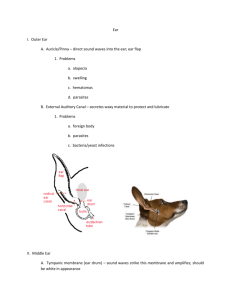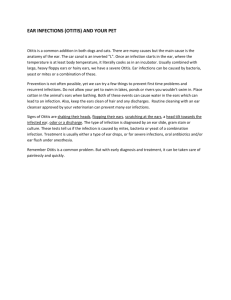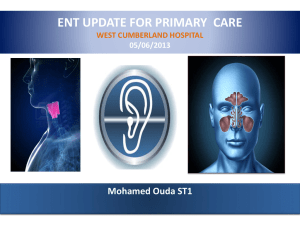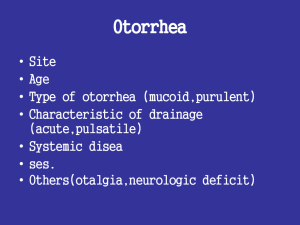Blue Jays Proposal
advertisement
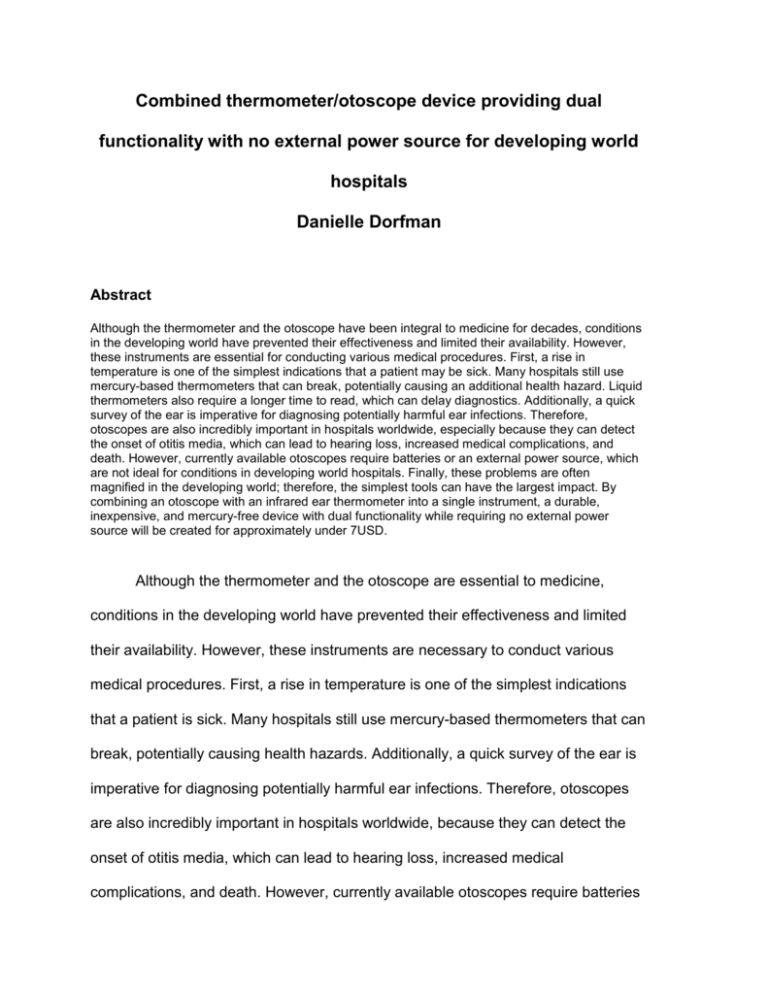
Combined thermometer/otoscope device providing dual functionality with no external power source for developing world hospitals Danielle Dorfman Abstract Although the thermometer and the otoscope have been integral to medicine for decades, conditions in the developing world have prevented their effectiveness and limited their availability. However, these instruments are essential for conducting various medical procedures. First, a rise in temperature is one of the simplest indications that a patient may be sick. Many hospitals still use mercury-based thermometers that can break, potentially causing an additional health hazard. Liquid thermometers also require a longer time to read, which can delay diagnostics. Additionally, a quick survey of the ear is imperative for diagnosing potentially harmful ear infections. Therefore, otoscopes are also incredibly important in hospitals worldwide, especially because they can detect the onset of otitis media, which can lead to hearing loss, increased medical complications, and death. However, currently available otoscopes require batteries or an external power source, which are not ideal for conditions in developing world hospitals. Finally, these problems are often magnified in the developing world; therefore, the simplest tools can have the largest impact. By combining an otoscope with an infrared ear thermometer into a single instrument, a durable, inexpensive, and mercury-free device with dual functionality while requiring no external power source will be created for approximately under 7USD. Although the thermometer and the otoscope are essential to medicine, conditions in the developing world have prevented their effectiveness and limited their availability. However, these instruments are necessary to conduct various medical procedures. First, a rise in temperature is one of the simplest indications that a patient is sick. Many hospitals still use mercury-based thermometers that can break, potentially causing health hazards. Additionally, a quick survey of the ear is imperative for diagnosing potentially harmful ear infections. Therefore, otoscopes are also incredibly important in hospitals worldwide, because they can detect the onset of otitis media, which can lead to hearing loss, increased medical complications, and death. However, currently available otoscopes require batteries or external power source, which are not ideal for developing world hospitals. By combining an otoscope with an ear thermometer into a single instrument, I plan to create a durable, inexpensive, and mercury-free device with dual functionality while requiring no external power source. Medical thermometers commonly use infrared thermometry technology. In such a thermometer, a thermocouple utilizes two different metals joined at two junctions, one located in the ear and one exposed to the room temperature. If the temperature varies at the junctions, a circuit can measure the induced voltage, and the temperature difference, ΔT, can be calculated. The temperature of the room, measured by a thermistor, is then added to ΔT to determine body temperature. Otoscopes also use simple technology for medical diagnostics. This design was considered when determining the circuit of my device, but each component (thermocouple and thermistor) is relatively expensive to the device as a whole. With further research, I found a Precision Centigrade Temperature Sensor (LM35 series, National Semiconductor). The voltage output of these sensors is linearly proportional to the temperature in Celcius (10mV/ºC). According to the data sheet, “the LM35 does not require any external calibration or trimming to provide typical accuracies of ±1⁄4°C at room temperature and ±3⁄4°C over a full −55 to +150°C temperature range”, which incorporates healthy human body temperature (approximately 37°C) and unhealthy ranges as well (exceeding 38.9°C)i. Although not as accurate as the thermocouple/thermistor combination, the LM35 Temperature Sensor is a more sustainable, inexpensive, less circuitry intensive alternative. The LM3914 Dot Bar Display is used within the circuit to correlate the changes in voltages of the LM35 with corresponding LEDs. There are three LEDs that correspond to the temperature range desired. The first LED (green) initiates temperature sensing and tells the user that the device is ready to measure a temperature. This LED is calibrated to room temperature with an input voltage of approximately 210 mV. The second LED is referred to as the “healthy” temperature range and corresponds to an input voltage of approximately 300 mV. The third LED is red and corresponds to the “unhealthy” temperature and approximately 386 mV. The diagram of the circuit is pictured below (input voltage is approximately 3V). A typical otoscope incorporates a light source directed through a funnelshaped speculum with a magnification lens. In this device, a long lasting LED has been incorporated into the circuit below to provide accuracy of detection for the inner ear. The circuit is pictured below (R1=9KOhms, V+=9V). Both units can be powered by an induced current generated by mechanical work (e.g. a hand crank). However, because of time constraints, the first generation device is powered by a 5 volt battery. In future generations, a mechanical source of energy will be incorporated. The device proposed can be used in the treatment and care of a vast array of diseases because of the capabilities of both the thermometer and the otoscope. As previously mentioned, an increased body temperature is one of the first signs of illness, and this device will incorporate this indicative tool into a device that can also detect infections and medical complications of the ear. Ear infections are common amongst all populations, demographics, and regions of the world, especially in children. Chronic otitis media (COM), a form of chronic ear infection, is the leading cause of hearing impairmentii, and any form of ear infection is harmful. Due to the anatomical position of the middle ear cleft, further spreading of the infection is potentially fataliii. The advantages of the thermometer technology that will be used in this device (over a traditional alcohol or mercury-based thermometer) include increased accuracy, non-toxic components, and quicker results, which are of importance in understaffed hospitals. Some hospitals in developing nations are not able to purchase new alternatives and are still using mercury thermometers. These thermometers are easily broken and will cause harmful mercury spills, affecting both the patients and the environment. If not disposed of properly, these spills can contaminate indoor air and come into contact with skin, leading to serious health consequences. In India alone, the health care sector spills an estimated 2.4 metric tons of mercury a year, causing potentially serious damage to the brain and central nervous system of both the patients and staffiv. A sustainable and safe thermometer would help improve healthcare and also reduce occupational hazards and potential harm to patients. Also, the prevalence of ear infections coupled with the shortage of otoscopes poses a great health risk to those in the developing world. Without an otoscope, chronic otitis media can go undetected, leading to more serious harm to the body. Studies observing the effects of hearing loss due to ear infections before the age of two have linked learning disabilities and poor scholastic performance with the occurrence of otitis mediav. It has been estimated that 28,000 deaths in 1990 were attributed to otitis media complicationsvi. In a 1996 study, the World Health Organization estimated that approximately 2.163 million disability adjusted life years (DALYs) were lostvii. More than 94% of these DALYs are attributed to developing nations. Therefore, by making our otoscopes with inexpensive yet durable materials (such as expensive metals), we will provide a more cost-effective device. This device will incorporate the advantages of both instruments, while remaining inexpensive and using mechanical user-generated power, which are crucial for hospitals with limited funds and electricity sources. i LM35DT Data Sheet (in Appendix). Acuin, Jose. Chronic Supperative Otitis Media: Burden of Illness and Management Options. Geneva: World Health Organization, 2004. Web. iii Mawson SR and Ludman H. Diseases of the Ear, a Textbook of Otology. 4th edition. London: Edward Arnold, 1979. 366–425. Web. iv Harvie, Jamie and Karliner, Joshua. The Global Movement for Mercury-Free Healthcare. Philippines: Health Care without Harm, 2007. Web. v Teele DW, Klein JO, Chase C, Menyuk P, Rossner B. Otitis media in infancy and intellectual ability, school achievement, speech and language at age 7 years. Journal of Infectious Diseases 162 (1999): 658-694. v Teele DW, Klein JO, Rosner BA. Otitis media with effusion during the first three years of life and development of speech and language. Pediatrics 74-2 (1984): 282-295. vi Investing in Health Research and Development. Geneva, World Health Organization, 1996. ii vi Murray CJL, and Lopez AD. Deaths by age, sex and cause (thousands), 1990. Global Burden of Disease. Geneva, World Health Organization (1996): 433-468. vii Murray CJL, Lopez AD. DALYs by age, sex and cause (thousands). Burden of Disease. Geneva, World Health Organization (1996): 541- 576.
